Crystal Siberians of Mankato, Minnesota, Presents:
The Breed Standard
|
Sunt-Andre Zoya of Kravchenko What is the Siberian Cat Breed Standard? (Description provided by TICA, Picture by Lynda Nelson.) GENERAL DESCRIPTION: The Siberian is a large, strong cat that takes 5 years to mature. The females may weigh less than the males. They are extremely agile and great leapers. Their muscles are mighty, outstanding and powerful. The back is long and very slightly curved or arched, but appears horizontal when in motion. Convex muscular waist and round, compact belly develop with age. The hind legs, when straightened, are slightly longer than the forelegs. The paws are round, big and powerful. The overall appearance should be one of great strength, force and size with an excellent physical condition and alertness; the facial expression is quite sweet. The general impression is one of roundness and circles, rather than rectangles and triangles of similar breeds. HEAD: The head is a modified wedge of medium size with rounded contours, broader at the skull and narrowing slightly to a full rounded muzzle with well-rounded chin. There may be a slight muzzle curvature, but the transition between the side of the head and the muzzle is gentle and inconspicuous. The cheek bones are neither high set nor prominent. There should be a good distance between the ears and eyes. The top of the head is flat, with a slight nose curvature of a gentle slope from the forehead to the nose and a slight concave curvature before the tip. The neck is medium-long, rounded, substantial, and well-muscled. TAIL: The tail is medium in length, wide at the base, blunt at the tip without thickening or kinks, evenly and thickly furnished. EARS: The ears are medium-large, wide and set as much on the sides of the head as on the top; ideal position is 1 to 1-1/2 ear widths apart. The tips are rounded and the ear tilts forward. Lynx tipping is acceptable. Hair over the back of the ears is short and thin; from the middle of the ear, the furnishings become longer and cover the base completely. EYES: The large, almost round eyes are set wide with the outer corner slightly angled toward the lower base of the ear. There is no relationship between eye color and coat color/pattern; however, the typical adult color is yellow-green. COAT: This is a moderately long to longhaired cat, with hair on the shoulder blade and lower part of the chest being thick and slightly shorter. There should be an abundant ruff setting off the large, impressive head. There is a tight undercoat, thicker in cold weather. Allow for warm weather coats. The coat gives the impression of lacquer and oil when ungroomed. The hair may thicken to curls on the belly and britches, but a wavy coat is not characteristic. The skin may have a bluish cast. Clear strong colors and patterns are desirable, but are secondary to type. ALLOWANCES: Buttons, spots or lockets. PENALIZE: Adult cats not having substantial weight. Straight profile. Narrow or fox-like muzzle. Almond shaped eyes. Very long legs. Siberian Cat Breed History: Siberians have been around for at least one thousand years as far as recorded history. They were first mentioned in Harrison Wier's book Our Cats and all About Them, which included information about one of the earliest cat shows held in England in 1871. However, finding written information in Russia is fairly difficult. Despite the fact that the Siberian is a natural breed and is the national cat of Russia, its very ubiquity makes it taken for granted rather than worthy of note in Russian literature. Add to this the vast expanse of Russia which encompasses 13 time zones as well as a multitude of ethnic and cultural diversity and you have a cat that seems as difficult to standardize as the country which gave rise to it. The Siberian, considered a semi longhair, has a rich full coat in the winter while the summer allows for a somewhat shorter less dense coat. The Siberian can come in just about every color of the rainbow but because of the rarity of the breed those colors may not be available in your neighborhood. The Siberian was accepted into the Miscellaneous class by CFA on February 6, 2000.
The Siberian cat is a natural breed from Russia. They are found in St. Petersburg Moscow and Leningrad. The first Siberians entered the United States in 1990. For a significant period of time, it was against the law in Russia to own and feed 'pets'. The Siberian ran the streets of Russia and survived 'underground'. Many found refuge in monasteries which in itself has been part of the historical lore of the Siberian. Int.Ch.Odissey Onix Gloria of Rossity
Features: Most people who exhibit allergies to other cats, have little or no reaction to the Siberian. Siberians are loyal and friendly and make great companions. Their personalities are often referred to as dog like and do in fact exhibit protective qualities. Siberians are not an extremely vocal breed, they express themselves with a soft chirping. This is an intelligent cat with a bold wedge shaped head, rounded contours and expressive eyes. They are a semi-longhaired breed with thick undercoats that require minimal grooming. They are accepted in all color patterns. The Siberian is slow to mature, taking five years to reach full maturity. Standard: General Description The Siberian is a large, strong cat which takes 5 years to mature. The females may weigh less than the males. They are extremely agile and great leapers. Their muscles are mighty, outstanding and powerful. The back is long and very slightly curved or arched., but appears horizontal when in motion. Convex muscular waist and round, compact belly develop with age. The hind legs, when straightened, are slightly longer than the forelegs. The paws are round, big and quite powerful. The overall appearance should be one of great strength, force and size with an excellent physical condition and alertness; the facial expression is quite sweet. The general impression is one of roundness and circles, rather than the rectangles and triangles of similar breeds.
Head: The head is a modified wedge of medium size with rounded contours, broader at the skull and narrowing slightly to a full rounded muzzle with well-rounded chin. There may be a slight muzzle curvature, but the transition between the side of the head and the muzzle is gentle and inconspicuous. The cheek bones are neither high set nor prominent. There should be a good distance between the ears and eyes. The top of the head is flat, with a slight nose curvature of a gentle slope from the forehead to the nose and a slight concave curvature before the tip. The neck is medium-long, rounded, substantial, and well-muscled. Tail: The tail is medium length, wide at the base, blunt at the tip without thickening or kinks, evenly and thickly furnished. Ears: The ears are medium-large, wide and set as much on the sides of the head as on the top; ideal position is 1 to 1-1/2 ear widths apart. The tips are rounded and the ear tilts forward. Lynx tipping is desirable. Hair over the back of the ears is short and thin; from the middle of the ear, the furnishings become longer and cover the base completely. Eyes: The large, almost round eyes are set wide with the outer corner slightly angled toward the lower base of the ear. There is no relationship between eye color and coat color/pattern, however, the typical adult color is yellow-green.
Coat: This is a moderately long to longhaired cat, with hair on the shoulder blades and lower part of the chest being thick and slightly shorter. There should be an abundant ruff setting off the large, impressive head. There is a tight undercoat, thicker in cold weather. Allow for warm weather coats. The coat gives the impression of lacquer and oil when ungroomed. The hair may thicken to curls on the belly and britches, but a wavy coat is not characteristic. The skin may have a bluish cast. Clear strong colors and patterns are desirable, but are secondary to type. For a breed that began his journey to America 11 short years ago, the Siberian has purred his way into the hearts of North American cat lovers in record time. These cat comrades, known for their size, luxurious fur, and almost dog-like devotion, have achieved recognition in seven of the ten North American cat associations since their arrival in 1990; an amazing feat, and an indication of their appeal. Siberian Cat History - Timeline 1000 - Siberians first appeared in recorded history. Siberian Cats from the unforgiving climate in Siberia first appeared in recorded history around the year 1000. 1700 - Siberians at first cat show in England. The Siberian cat was one of the three longhairs represented at the first cat shows held in England in the 1700's. 1900 - First entry into USA found in a book. First entry into USA, found in a book -- originally published in 1900 by Helen M.Winslow entitled "Concerning Cats," "Mrs.Frederick Monroe of Riverside Ill. owns a remarkable specimen of a genuine Russian cat, a perfect blue of extraordinary size. The Russian long-haired pet is much less common even than the Persian and Angora." 1960 - First feral pointed patterned cats found. Russian People had thought that long ago the feral pointed patterned cats and the feral Siberian cats "got together" along the banks of the Neva River in Leningrad (which is now named St. Petersburg) in the 1960s. 1987 - The first cat show in the city of Leningrad, Russia. It was organized by two cat clubs ‘Kotofei’ and ‘Kis’. This is the actual date of the beginning of breeding of Siberians in St. Petersburg. The Soviet Felinological Association registered the Siberian breed. It included both the traditional colors and the Siberian color point (Neva Maskarade). 1990 - 06/28/90 Siberians First Arrived in USA. The first breeding Siberians were introduced in the United States in 1990. Elizabeth Terrell imported the initial kittens. They arrived on June 28, 1990. Their names were KALIOSTRO VASENJKOVICH OF STARPOINT, OFELIA ROMANOVA OF STARPOINT and NAINA ROMANOVA OF STARPOINT. 07/24/90 - Registration accepted in ACFA. The original 3 Siberians imported by Beth Terrell were accepted for registration in ACFA 10/15/90 - First magazine article in USA. Cat Companion from Friskies contained the first article about Siberians. 8/??/90 - First ACFA show in USA Fort Worth 8/??/90 - First TICA show El Paso 1991 - WCF accepted a working Siberian Standard 7/13/91 - First Siberian Litter sired and born in USA. "Anastasie gave birth to the first litter sired by Aleks - 3 babies in litter Linda Gray and Mary Armentrout both of Maine were the first ones to purchase breeding cats from Beth " Kotofei met in 1991 to establish their own Siberian standard. 1992 - 02/23/92 ACFA granted Siberians probationary status. ACFA semi annual approved the standard and granted probationary status 03/06/92 TICA accepted the standard. TICA accepted the standard with some adjustments & put Beth & Foye & Sandy Roberson on breed committee 03/08/92 CFF granted Siberians experimental status. CFF accepted the standard and the Siberian as Experimental - ( the first registry we had to work from the ground up 03/??/92 CCA, NCFA, & ACA approached CCA. NCFA ( later accepted ) & ACA approached & approved standards CFF 91-92 show season first National year end award Starpoint's Irida Kaliostrovna earned the title of 2nd Best Experimental in CFF 11/??/92 TAIGA formed 11/92. The first Siberian Breed Club was formed by Elizabeth Terrill for the promotion of the Siberian breed through out all registries. 12/24/92 Second generation of Siberians born in USA. First litter of Starpoint kids born out of Starpoint Cattery to Mary Armentrout in Maine 06/24/93 First introduced to CFA. "The Siberians were first presented to CFA in 1993 by Linda Gray, but were not accepted for MISC. class. Starpoint's Irida Kaliostrovna & Starpoint's Karina Loukanovna - another cat was there from another importer from CA but did NOT look like the 2 Starpoint cats." 12/11/93 First Siberian Champion. First Siberian Champion in any registry - AACE - Audrey Oliver with non Starpoint cats - AACE accepted for championship immediately 1993 - AACE new registry formed Siberian Accepted 1994 - Russian Standard Official standard was accepted by the expert commission of WCF in 1994 03/10/94 Asked to present Siberians to CFA Board. Tom Dent ( CFA EXEC DIR ) asked Beth to present Siberian to board - she declined due to the expense ( remember they also invited the breed in 93 ) she sent written presentation 05/01/94 CFF accepted Siberian as provisional. Siberian grandfathered in as Provisional by CFF after a changing of their Experimental rules 10/30/94 First Grand Champion AACE - Troika Zahar Ahlmazovich 11/26/94 Largest competitive Siberians in one show. Largest competitive Siberians in one show - 13 - CFF 1995 - Russian Standard published 04/30/95 First Supreme Grand AACE Troika Zahar Ahlmazovich 05/06/95 CFF accepts Siberians for Championship Standard of St.Petersburg Felinological Society and was published in the compilation of WCF standards. 05/07/95 ACA accepts for championship 1996 - 01/01/96 Siberian accepted in Italy 05/01/96 CP accepted for championship in AACE 05/01/96 first Siberians in Canada 06/09/96 1st GRC Siberian in CFF Comrade Vashin Paschanovich- 1st and still only GRC in CFF 08/31/96 TICA accepted Siberians for championship 1997 - 02/28/97 Color point introduced in the US First color point was imported by Dana Osborn. 05/01/97 CP's accepted for NBC in TICA 1998 - 02/24/98 1st litter of colorpoints born 8 babies - Dana Osburn 09/01/98 1st white Siberian enters US Barbara Naame 09/01/98 1st Siberian in Hawaii 1999 - 02/20/99 ACFA accepts breed for Championship 2000 - 05/01/00 Accepted in CFA as MISC Accepted for Misc. Class in CFA. 2001 - 04/30/01 Siberian is TICA International Cat of the Year "IW,SGC Treskuchiy Sibirskiy Moroz Mur Owner: Dan & Judy Chappetta" 2002 - 05/01/02 CP advances to championship in CFF 05/01/02 CP advances to championship in TICA |
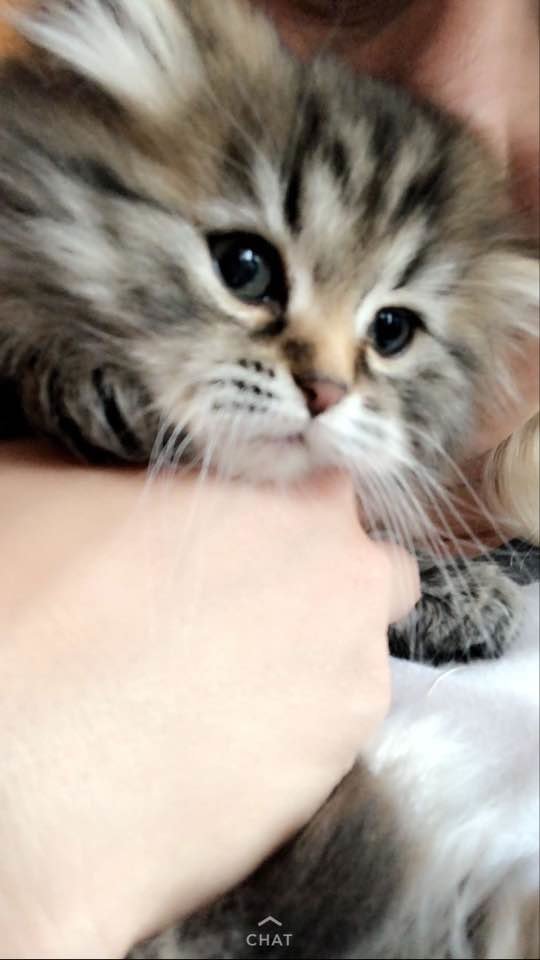
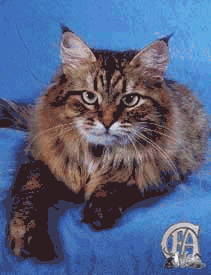
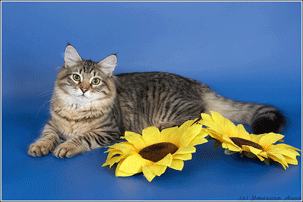 Sharlota of Crystal Siberians
Sharlota of Crystal Siberians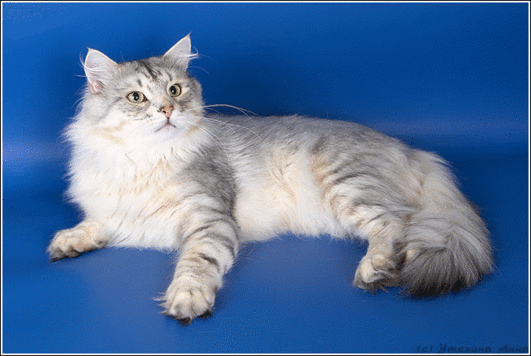
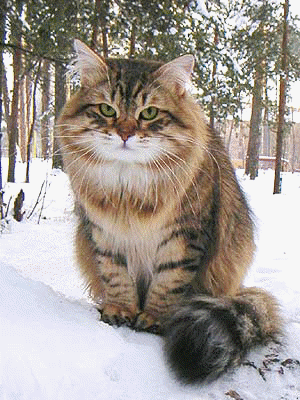 Earl Martin of Valenvic Cattery
Earl Martin of Valenvic Cattery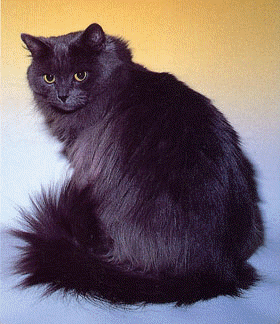 WCH Arisha Valenvic
WCH Arisha Valenvic 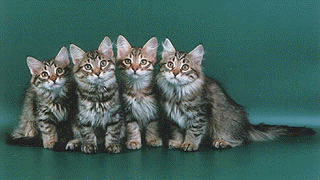 WCH Europa Valenvic Litter
WCH Europa Valenvic Litter